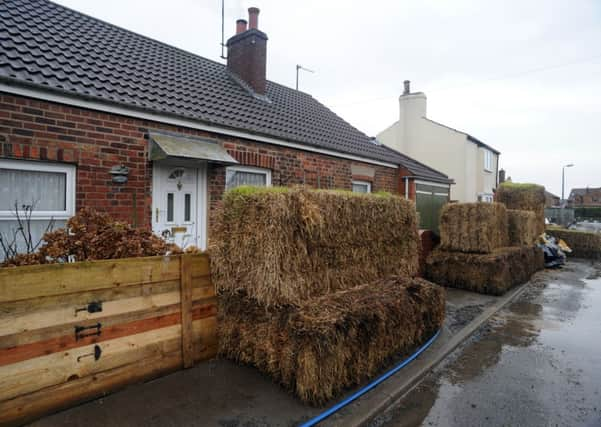Hard rain’s gonna fall so it pays to prepare for flooding


Scenes of streets turned into rivers by devastating downpours have shocked the nation and put fear into the hearts of homeowners everywhere.
According to the Royal Institution of Chartered Surveyors, there is cause for concern. Of the 28 million homes in Britain, five million are risk of flooding.
Advertisement
Hide AdAdvertisement
Hide AdThe RICS also believes that there will probably be more floods in the future, due to changes in weather patterns and the amount of new building on low-lying areas in recent years.
Water damage is the most significant worry. It wrecks everything from wiring to treasured possessions. Drying out can take months and renovation even longer. Then there’s the stress of dealing with loss assessors.
Added to that are fresh anxieties over property values and saleability thanks to a clamp down by mortgage and insurance companies.
A growing number of lenders in flood prone areas are insisting that borrowers have building insurance in place before their mortgage is advanced. Many buyers are unable to find it or discover that premiums are too expensive and sales fall through.
Advertisement
Hide AdAdvertisement
Hide Ad“More postcodes are falling into flood areas and a lot of big direct insurers won’t touch them,” says Simon Waring, of Ryburne Brokers in Hebden Bridge.
“Using a local insurance broker can help. We have found one company that will insure our clients if cover is either excluded for the basement or you agree to pay a large excess. These conditions mean that buyers can still get a mortgage.”
Flood RE, an agreement between government and insurers to provide cover for 500,000 hard hit homes, may help alleviate the problem when the scheme launches in summer 2015. Simon also suggests that those who have been flooded invest in a survey to assess risk and defence strategies. They range from £500 to £1,500 and are becoming increasingly popular.
Skipton-based JBA Consulting has seen an increase in the number of domestic flood surveys it carries out. Technical director Mark Bentley says: “Everyone who buys a house gets a basic screening report to check if flooding and contamination are an issue but that doesn’t examine detail like where the water might come from, how it will get into the house, which way it will run and how deep it might get, or how to protect your home with measures like flood boards.”
Advertisement
Hide AdAdvertisement
Hide AdYou can check general flood maps on the Environment Agency website, though they are contentious. Tim Blenkin, of York estate agency Blenkin and Co,says: “The map colours the whole of the Vale of York blue to denote the probability of flooding and that has a negative impact on property. Any buyer unfamiliar with the area inevitably asks, ‘does it flood?’ even if a property is on a hill.
“We cannot reassure them about future probabilities, only tell them of the record so far, but the levels of ignorance and alarm are astonishing.”
Tony Ruddiman, of Huddersfield-based The Flood Company, which specialises in flood proofing, says 75 per cent of his customers haven’t suffered “water ingress”.
“They see it is a possibility and want to be prepared,” he adds.
Advertisement
Hide AdAdvertisement
Hide AdDefences for domestic properties don’t have to be expensive, according to Tony, who suggests replacing standard air bricks with automatic versions that close in a flood. They cost about £70 but will stop 5,000 litres of water an hour gushing through open vents.
Plastic barriers to protect front doors cost £375 each, while a submarine-style flood door is £2,000. Instead of sandbags you should invest in Flood Sax, which Tony describes as “huge absorbent nappies”. They cost around £125 for a pack of five. Homeowners should also ensure that the pointing at the base of the house is good and that pipes leading to the outside drain have non-return valves.
While surveys and defences can be a good investment, Edward Hartshorne, of Blenkin and Co, says that flooding doesn’t always deter buyers. He points to the sale of The Old Vicarage, a riverside property at Acaster Malbis, near York.
“A few days before exchange of contracts the buyer rang to ask if the River Ouse had ever flooded. I confirmed it had and a day later the ground floor was duly swamped in a foot of water,” says Edward.
Advertisement
Hide AdAdvertisement
Hide Ad“The buyer was still happy to exchange at the agreed price. What does this tell us? If a riverside cottage is 300 years old, has happily survived and been adapted to endure occasional floods. If the seller is up-front about this and if the buyer is happy to take it on, then there is no problem. After all, the guide price takes the flooding history into account and the demand for such a house, whilst reduced, does attract significant interest from those who simply want a house with beautiful river views.”
Useful contacts: Flood maps: maps.environment-agency.gov.uk; www.jbaconsulting.com; www.thefloodcompany.co.uk; www.ryburne.co.uk. RICS publish a flooding guide for homeowners: www.rics.org